Growing succulents in a glass container such as a bowl or jar can offer a few handy benefits.
Aesthetically, they look stunning. You can see the whole plant in all their glory and admire every piece of them.
Another advantage of a transparent growing container is that you can see if any problems arise a little easier than with a normal type of pot.
Including overwatering, roots rotting, etc. Lastly, the lack of drainage holes mitigate any risk of spilling.
Setting these pots up correctly is important as the plants will need to be monitored more carefully. We’ll get to that shortly though.
In this article we’ll go through a step by step guide on how to plant succulents in glass bowl as well as other key tips worth grasping the concept of. Let’s dive in shall we?
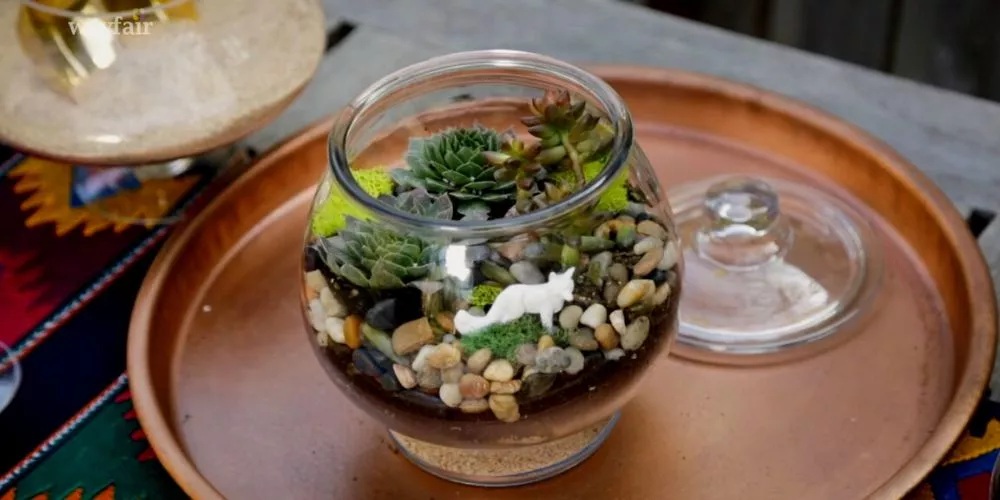
Table of Contents
How To Plant Succulents In Glass Bowl (Step-By-Step Guide)
Learning how to plant succulents in glass bowl can seem like a daunting task.
How do you prepare the plant? What type of soil do you use? How do you actually add the plants in?
Luckily, we have researched and mastered this easy to follow step by step guide to help remove the guesswork. Let’s go….
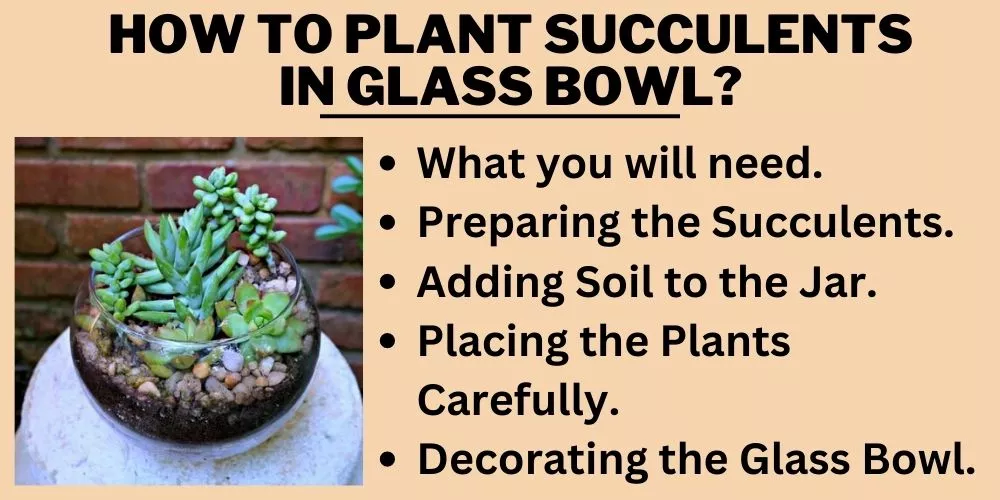
Step 1: Arrange the Things That You Will Need
A container
A glass bowl is considered anything that will hold the plant comfortably. Eg: mason jars, terrariums, transparent bowls, short but broad drinking glasses, etc.
A potting medium
This will need to be something that not only drains well but dries up fast. Most glass containers don’t have drainage holes so the last thing you want is to overwater your plant and the roots rot as they sit in water that won’t dry out.
Your choice of planting medium is going to make or break your plant! Some of the best growing mediums for succulents are self blended. We’ve found that Bonsai Jack is not only a great all round brand but an even better base mix for succulents.
Furthermore, a more porous material should be added to assist with aeration and drainage. The most ideal materials are things such as coarse sand and perlite.
The best ratio for a succulent potting mix is 2:1:1. So use 2 parts potting mix to 1 part coarse sand and 1 part perlite.
A plant
The type of plant you choose will be based on personal preference.
If you wish to plant a couple of different succulents in an arrangement then try to choose plants with similar lighting, watering, feeding and space requirements. This will make them easier to maintain in the long run.
Extras
You may need a small tool such as a gardening trowel to enable maneuverability of the soil. Additionally, some clay pebbles can be added to the very bottom of the pot to help with drainage.
Step 2: Preparing the Succulents
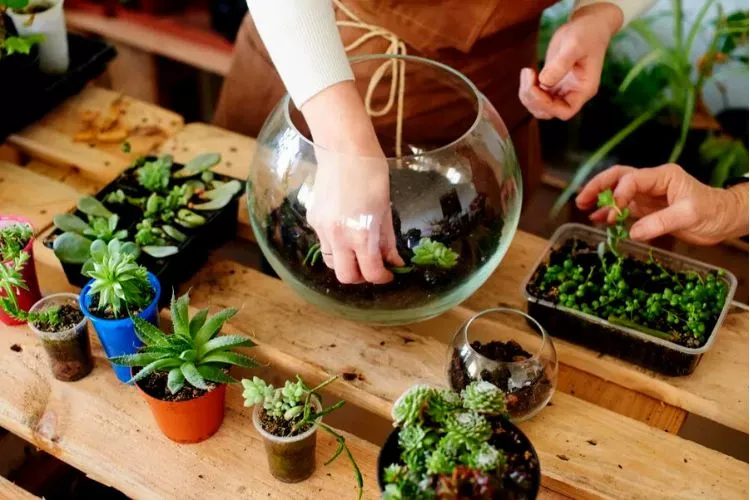
- Firstly, remove them from their place of origin. This could be a container you already have or even one that you purchased it in from the nursery.
- Gently remove all of the growing medium that it is being grown in. Use a soft pouring hose to clean the bits closest to the roots. Quite often, nurseries and other grower outlets will use their own potting mix that may not necessarily be of a decent quality. It’s always good to create your own mix.
- Remove any decaying or dead leaves and/or foliage to freshen the plant up.
Step 3: Adding Soil to the Jar
- Depending on the species of succulent, you may want to add a layer of clay pebbles to the bottom of the container to help soak up any stray moisture that could get trapped down there. Some species soak up water faster than others. It may take a bit of trial and error.
- Fill half of the growing container with your own blended potting mix. (2 parts potting mix to 1 part coarse sand and 1 part perlite).
Filling only halfway will allow you to be able to maneuver the plant. It gives you the space to add anything considered decorative without the plant being in the way.
Step 4: Placing the Plants Carefully
- Dig a hole in the newly laid soil slightly larger than the root ball of the succulent you wish to plant.
- Gently lower your plant into the container and into the hole.
- Making sure the plant is standing upright (or in the position you would like), gently press some of the surrounding soil to lock the plant into place. Don’t forget to get it sitting at the right height before fixing it into position.
- Add the rest of the mix into the container and pack the soil around the plant to keep it stable.
Step 5: Decorating the Glass Bowl
This last part is definitely personal preference. There are many items you can decorate your newly planted succulent with. For example, you can use black, white or maybe another color sand, rocks/pebbles, shells, anything else considered decorative that you really enjoy.
To top it all off, give the plant some water. Make sure that you add water slowly so you don’t drown the hard work you’ve just put in. Keep your succulent moist.
Should You Plant A Succulent In A Glass Jar?
Planting a succulent in a glass container such as a bowl or jar is definitely something that needs a bit more care than a normal pot or container.
Of course, they are a really nice addition to any home but there are some issues that can occur in using a container such as glass.
Generally, a glass container doesn’t have any drainage holes so you always have to make sure to get the water balance just right.
The perfect amount of water can also be hindered by poorly draining soil. So as long as you make sure your setup and water schedule is seamless then you should be able to minimize any risks involved in those areas.
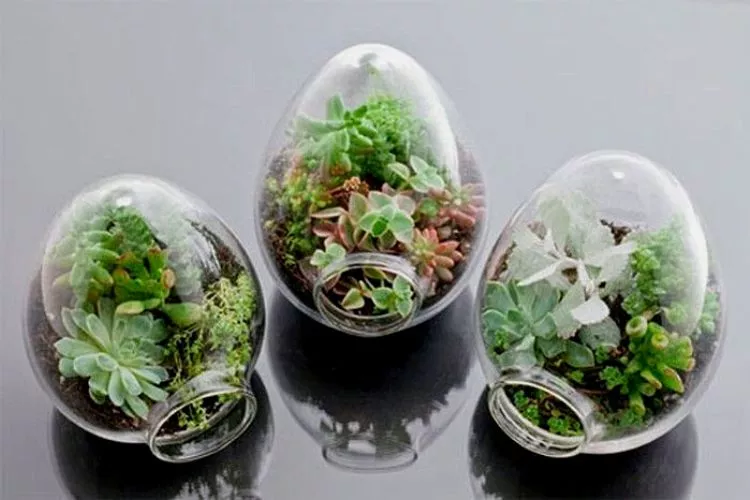
Additionally, using glass as a growing container is best suited to indoor environments. You can control them much more easily, they stay cleaner and of course won’t be subject to any abnormal weather issues.
Overall, growing a succulent in a glass container should definitely be considered if you’re a hands-on gardener.
There’s something about watching a plant grow from all angles that makes it all worth its while. If you are more of a set and forget type though, you probably want to avoid using glass.
How To Water Succulents In A Glass Jar?
There isn’t any universal watering method for a succulent in a glass container. The beauty of the glass is that you can see exactly what is happening inside the container at all times.
You can see if the soil is soggy, if the plant’s root system has become damaged, as well as the actual level of the water itself.
This will allow you to determine what action to take and when to take it. Watering a succulent is as simple as looking out to see if the soil is completely dry.
If so then slowly give your plant a drink and watch as the water slowly seeps in to ensure you are not overwatering. If the container is larger and the soil isn’t as easy to watch then you can also:
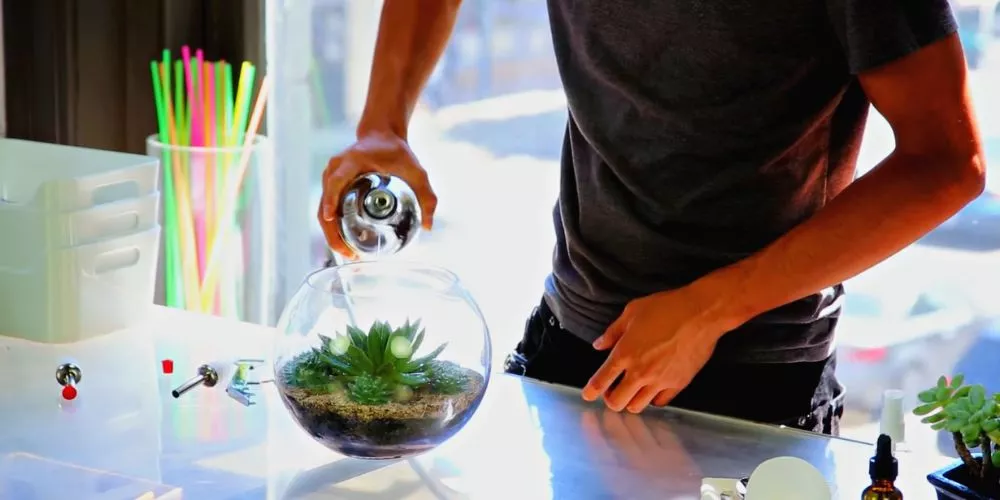
- Weigh the container – By weighing the container while the soil is dry, you will be able to determine the exact amount of water that the plant receives each time. Simple weigh before, fill with water then weigh again. You can then weigh the water each time so you know the amount you are giving is always right…
- Use a measuring jug – Similar to weighing except you will judge more by eye the first time around. As long as you know the exact volume of water that your succulent is receiving the first time, you can fill the measuring judge to that amount each time.
- Use another slower filling method – Smaller squeeze bottles, sprays and pipettes can be used in the exact same way. The difference is the amount being given is released slower using these methods. They may allow the soil to become moist a little more evenly than the other 2 methods.
Other Key Things To Take Note Of
There are a few other minor issues that need to be taken into consideration when planting succulents in a glass container. Factors such as if fertilizer is needed, as well as what type and how much?
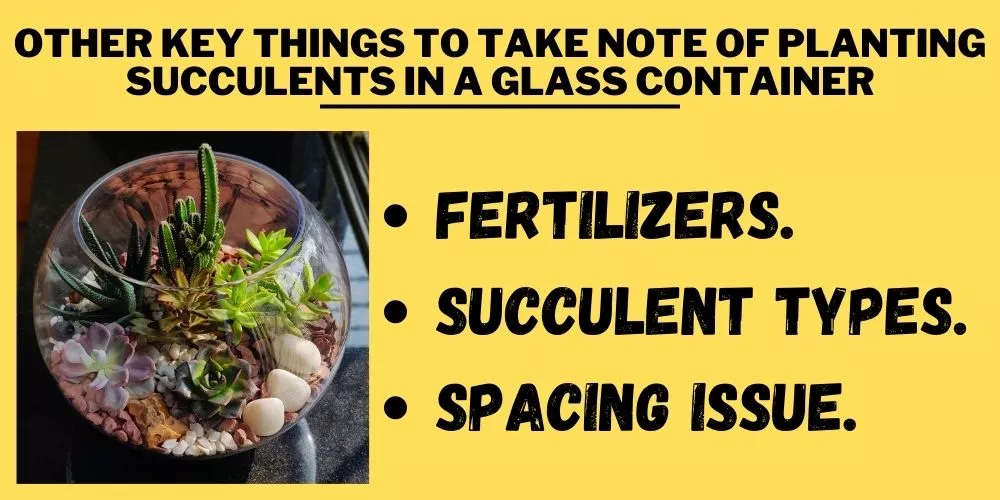
Not to mention the different types of succulents that can be used and also spacing the plants with enough room. Let’s have a look at these issues in a little more detail.
Fertilizers
Regardless of the type of container your succulent is growing in, they will need fertilization. Almost all plants need some kind of food routine to ensure they grow to their full potential.
However, succulents in general don’t require as much fertilization as ‘normal’ plants.
As long as you have created a soil blend that offers a lot in the way of natural nutrients then you will only need to supplement the plant with fertilizer once per year. A balanced 15-15-15 mix is perfect. You can also use a manure tea or fish emulsion to achieve great results.
Succulent Types
Succulents are a great choice of plant to use in glass containers because they are generally not so messy as far as plants are concerned. Their leaves are thick and plump and rarely shed anything that needs constant cleaning.
Additionally, they have the uncanny ability to help purify the air from toxins as well as humidity your home. Lastly, they are pretty simple to maintain.
The lush vibrant colors can also put a smile on anyone’s face. If growing multiple succulents in one container, it’s recommended that you choose plants that have similar growing needs.
Eg: the same lighting requirements, amounts of water needed, soil needs, etc. Some of the best species of succulents to plant in glass containers are:
- Pincushion Cactus
- Medicine Plant
- Hens & Chicks
- Paddle Plant
- Zebra Haworthia
- Burro’s Tail
- String Of Pearls
- Tiger Jaws
- Agave
Spacing Issue
Spacing your succulents properly is not only an artform but also a requirement that ensures you don’t run into problems as they start growing bigger.
The roots can start clashing with each other as they try to spread out. This can cause them to become bound and you may need to remove them and give them a little extra space before it’s too late.
However, planting them closer to each other gives a more polished or professional look. The other issue with this proximity is the inability to evenly distribute water.
The plants will often fight for moisture which can leave one with an excess of moisture and the other with none.
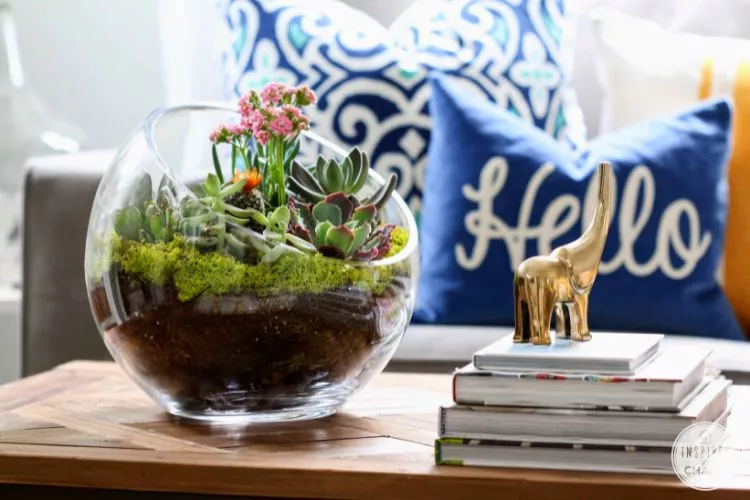
An easy way to help navigate this problem is by using a long, thin spouted watering can. You can get right in amongst the plant’s stem base with accuracy using one of these.
This process may need a bit of trial and error on your behalf to see what works and what doesn’t.
Frequently Asked Questions (fAQs)
What type of pot is the best for succulents?
Either terracotta or ceramic are hands down the best pots for growing a succulent. They allow the plant to breath, which does wonders for the root system when it comes to aeration and drainage underneath the soil.
The only real issue is the weight of these types of containers. It’s recommended to couple this type of pot with a set of wheels to help with maneuverability.
Can you plant succulents in pots with no holes?
Yes, it is definitely possible. You would need to make sure that you use a well draining soil that can also dry out pretty easily. Creating your own potting mix is as simple as blending a coarse sand and some perlite with your potting mix.
The newly created porus concoction will help to reduce the risk of any water pooling in the soil and causing the plants root system to rot as it lays in the stagnant water. It will also help with aeration which is essential for the breathability of the plant.
Do succulent bowls need drainage?
No, you can plant succulents in bowls without drainage but you need to make sure that you use a well draining soil mix to stop the water from pooling. Stagnant water can cause root rot if left for too long. This can take as little as 1-2 weeks.
Conclusion
As we have discovered, succulents can definitely be grown in glass containers. However they need to be set up with the right types of soil to enable the plant to thrive without hindrance. The key is to make sure that any water used on the plant can dry out and/or soak up to prevent any damage caused by pooling water.
It’s as simple as that! We hope that you have found this article helpful and we look forward to creating more content just like it to make your job easier in the garden. Thank you for tuning in and as always, happy growing!


